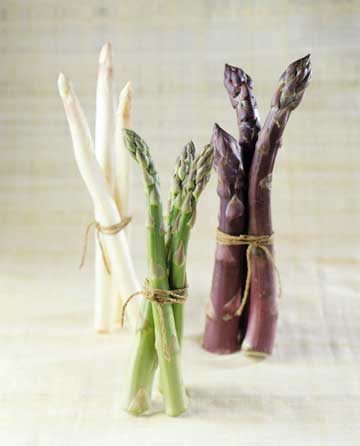Noted nutritional counselor Katherine Pennington (of Be in Balance) tells us why Asparagus does more than just make your pee smell funny;

Yes, that is a flower that you are eating! Believe it or not, the delicious Asparagus that you eat is actually a perennial garden plant and member of the lily family. Asparagus has been considered a delicacy since ancient times. Originating in the Easter Mediterranean region, cultivated in ancient Egypt as well as Africa, and then made wildly popular in the 18th century by Louis XIV, asparagus has been prized as an epicurean delight and for its medicinal properties for almost 2000 years!
Asparagus is a nutrient-dense food that is extremely high in folic acid and also contains substantial levels of potassium, vitamins B1, 2, 6, vitamin A, C, & K, niacin and thiamin. Folic acid or folate is responsible for protecting against birth defects, promoting healthy skin, protecting against parasites and food poisoning, and helping ward off anemia. Containing a wopping 263 mcg of folate per cup, asparagus is something that is very beneficial to add to your diet if you are thinking about getting pregnant or are in the early stages of pregnancy. Eat it!
Asparagus is also a diuretic. Asparagus contains 288 mg of potassium per cup and is very low in sodium. Due to its mineral profile and the active amino acid asparagine, asparagus is a wonderful diuretic which helps reduce water retention due to PMS (who doesn’t need that?!) and high blood pressure. Some experts also believe that asparagus improves symptoms of arthritis and rheumatism by breaking down the oxalic acid crystals, particularly if taken in a juice form.
Asparagus also improves digestion by promoting intestinal flora. Asparagus contains the carbohydrate inulin that we don’t digest, but the health-promoting friendly bacteria in our large intestine such as Bifidobacteria and Lactobacilli do. When our diet contains good amounts of inulin, the growth and activity of these friendly bacteria increase resulting in healthy bacteria population in our intestines that makes it difficult for unfriendly bacteria to take hold.
On top of all that, asparagus is an excellent source of fiber!
Now that May is upon us and harvest season of asparagus has officially begun, make sure you pick up some freshly gown asparagus and serve them raw with crudite for a snack, dice them in your favorite salad for lunch, or prepare them grilled as a side dish at dinner.
Below are some of my family’s favorite recipes!
Asparagus Pasta
Rigatoni or penne pasta (I prefer whole wheat or quinoa pasta)
Olive oil
Bunch of asparagus
1 clove of garlic
Parma (Parma! is a Vegan Parmesan which is all natural, made with organic walnuts, and super high in Omega 3 fatty acids and B-Complex vitamins! Eat it!)
Place the diced garlic and olive oil in a pan and allow to cook until tender. Dice asparagus into thin slices horizontally and add to garlic and olive oil and cook approximately 3-5 minutes until tender. Cook the pasta in a separate pot until done and then drain and place in a large bowl. Spoon the asparagus, garlic and olive oil on top of the pasta and serve with parma. This is truly a very simple, delicious dish!
Grilled Asparagus
Bunch of asparagus
Olive oil
Sea salt
Lemon
Optional: sprinkling of black or white sesame seeds
Coat a non-stick griddle with a bit of olive oil or olive oil spray. Place the asparagus on the griddle and drizzle with olive oil and then spice with a dash of sea salt and sesame seeds (those are totally optional, but do make things look pretty and a little fancier). Grill until brown. In our family, we love them when they are a bit crispy and very brown like they have been out on the grill but they can also be done al dente if you prefer.
Katherine Pennington of Be in Balance offers holistic health and lifestyle counseling for women and men who want to lose weight, gain energy, sleep better, reduce stress, get in shape and achieve a greater sense of well-being, balance and happiness in their lives and those of their families. Katherine is also a raw food chef and teacher and oversees juice fasts for clients. As a mother of two children, Katherine also helps with family meal planning on nutrition. To find out more , please visit www.be-n-balance.com.

